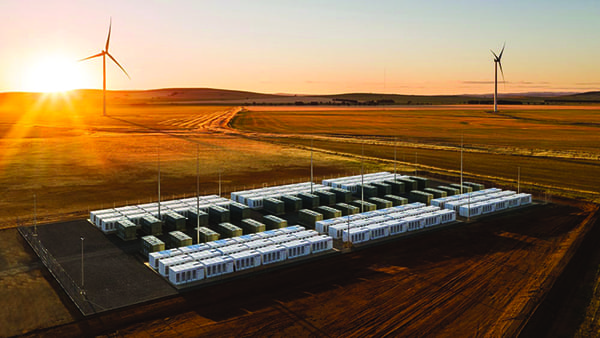Need for Resilience Supports Energy Storage
Independent power producer Neoen Australia said an expansion of the world’s largest lithium-ion battery system has completed its network connection, bringing the Tesla-supported Hornsdale Power Reserve, adjacent to a wind farm in South Australia, to a rated size of 150 MW/193.5 MWh.
It’s the latest in a series of projects being developed worldwide to add energy storage to solar arrays, at wind farms, and even thermal power plants as growth in battery energy storage systems (BESS) continues. The industry is moving forward, even though growth will likely be slowed by the coronavirus pandemic.
“This was expected to be a banner year,” said Kelly Speakes-Backman, CEO of the Energy Storage Association, in an April 17 interview with POWER. “We’re going to see a real hit on that, especially with behind-the-meter projects. People don’t want workers coming to their home, and businesses are closed.”

Speakes-Backman acknowledged the problems that storage and other energy industry sectors are facing from COVID-19, with equipment shortages and supply chain issues, along with a struggling economy, impacting project financing and construction. But she said the pandemic is highlighting some of the issues that make energy storage so important.
“The things that are pushing us forward have to do with resilience and making the grid stronger,” she said. “A lot of people that are going in for solar, are also going in for storage. On the commercial and industrial side, as opposed to a diesel backup generator, now they’re looking at providing for resiliency with storage. We certainly can see the importance of adding resiliency to hospitals and other critical facilities.”
Hornsdale Is Largest, but Not for Long
The Hornsdale project (Figure 1), adjacent to the 315-MW Hornsdale Wind Farm in Jamestown, South Australia (a POWER Top Plant in 2018), is an example of a storage project with several benefits. Neoen Australia reported work on the Hornsdale expansion network connection was completed earlier this month.

The project is designed to provide grid-scale inertia services and fast-frequency response on Australia’s National Electricity Network. According to the U.S. Department of Energy, the Hornsdale battery system has three times the power capacity of the world’s next-largest operating lithium-ion project, the 50-MW Stocking Pelham installation in the UK, although several larger projects in development will soon be jockeying for the top spot.
The Hornsdale project has its roots in a bet that Tesla CEO Elon Musk made with Australian billionaire Mike Cannon-Brookes, CEO of the Atlassian software company. Musk in March 2017 told Cannon-Brookes that Tesla could get the original 100-MW Hornsdale energy storage system installed and working in 100 days or less, from the date on which a contract was signed. The contract was signed in late September 2017, and the project entered operation in November of that year.
The Hornsdale battery system saved Australia about $40 million in grid stabilization costs in its first year, according to Aurecon, an Australian engineering and consultancy group, while generating about $50 million in revenue in less than two years through provisions of the Contingency and Regulation Frequency Control Ancillary Services and through arbitrage trading. The system has helped provide reliability and resiliency to South Australia’s grid, which is heavily dependent on renewable energy.
Hornsdale’s “synthetic inertia,” as it’s called when delivered by the battery storage, is similar to the system inertia provided by the turbines of fossil fuel-powered or hydropower units.
Speakes-Backman noted the emergence of new technology, such as General Electric’s (GE’s) LM6000 Hybrid EGT system, which integrates a BESS with GE’s LM6000 gas turbine. The technology enables contingency (spinning) reserve without fuel-burn between demand events, and also supports high-speed regulation, primary frequency response, and voltage support with the combined response of the gas turbine and battery storage system.
“On the grid side, we’re seeing examples of storage being put in with renewable energy, and gas-plus-storage is a new phenomenon we’re seeing, a gas-storage hybrid, with GE,” she said. “But it’s not just coupled, it’s to support the distribution grid, and transmission lines, to alleviate congestion. There are a number of reasons folks are doing this.”
Large U.S. Projects
Several large lithium-ion battery projects are being developed and are scheduled to come online this year and next, although the coronavirus pandemic could cause delays. U.S. projects include the Manatee Energy Storage Center, a 409-MW/900-MWh battery energy storage facility being developed by Florida Power & Light (FPL) in Manatee County, Florida. The project, which would be the world’s largest solar-powered BESS, is scheduled to come online in late 2021.
Vistra Energy Corp.’s 300-MW/1,200-MWh Vistra Moss Landing Energy Storage system, near Santa Cruz, California, has a 20-year agreement for the installation with Pacific Gas and Electric (PG&E). The project is co-located with the 1,060-MW gas-fired Moss Landing Power Plant.
NextEra Energy Resources Skeleton Creek project in Oklahoma would pair a 200-MW BESS with 250 MW of wind power and 250 MW of solar energy. The wind farm is scheduled to be operational by the end of this year, with the solar array and BESS expected online in 2023.
Tesla is building a 182.5-MW system on PG&E land in the existing Moss Landing substation, in Monterey County, California. Tesla has said the plant, which could be online by year-end, would help maintain local power capacity, but it also could bid into grid operator CAISO’s markets for energy, ancillary services, and more.
The Luna Storage Project is a 100-MW battery system being developed by sPower in Lancaster, California. The Clean Power Alliance earlier this month signed its first energy storage contract, a 15-year deal for Luna, which will be built on a 5-acre site near a Southern California Edison substation that serves sPower’s 75-MW demand-side response (DSR) solar farms. The Clean Power Alliance, a community choice aggregator, is looking to sign contracts with several energy storage projects.
Other U.S. projects include a 100-MW/400-MWh BESS being built in conjunction with the AES Alamitos Energy Center in Long Beach, California. The Alamitos Energy Center is a 1,040-MW gas-fired combined cycle plant. The BESS is expected to enter operation by 2022.
Strata Solar, a North Carolina-based solar developer, is leading development of a 100-MW/400-MWh BESS in Oxnard, California. Oxnard went with battery storage after rejecting NRG’s plan for the 262-MW Puente gas-fired plant. The Oxnard system could be online by year-end.
Arizona Public Service (APS) last year said it wanted to support its renewable power portfolio by adding as much as 850 MW of battery storage capacity to its solar power plants by 2025. APS already is partnering with Tempe-based First Solar to build a first-of-its-kind solar-plus-storage project that will be one of the largest in the country when completed in 2021.
‘Reliability and Affordability’
“I can tell you I don’t see this [coronavirus] crisis impacting the long-term ability of storage to grow,” said Speakes-Backman, who said initial project delays have occurred due to the inability to get equipment from China, which she said has “70% of global production capacity for batteries and components.”
She said the pandemic “is only going to increase demand for storage, for reliability and affordability. On the issue of resilience, there was a driver there and that’s being highlighted now, with some of these critical facilities needing a source of backup power without contributing to emissions.”
Speakes-Backman said her group was “expecting a 300% increase in storage deployment this year, so even a 50% drop in that means we’re still doing well. I really feel like this is going to be a near-term situation for our industry. People have already begun to realize the importance of energy storage to decarbonizing the grid, and I don’t think that goes away with this crisis.”
—Darrell Proctor is associate editor for POWER (@DarrellProctor1, @POWERmagazine).